History
The begining…
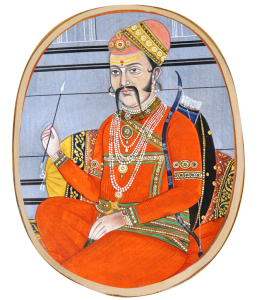
MahaRao Shekha Ji(ruled 1433-88) was the founder of the region. He was the chieftain of Amarsar in Amber where he refused to pay tribute to the Kachhawaha rulers of Amber- Jaipur. Thus breaking away, he proclaimed sovereignty in 1471 AD ad thus Shekhawati came into existence. Since then the Shekhawati region prospered witnessing the fight for power between the Rajput rulers and then against the Mughals.
Shekhawati was formerly a wealthy but lawless land on the trade route between the ports of the Arabian Sea and the fertile Ganges Valley. The Shekhawat Thakurs (noblemen), who once was noted for their indulgence in quarreling among themselves, began to flourish in the mid-18th-century British East India Company. While the Marwaris settled in the new coastal cities, they built Havelis for their families back home. Unfortunately, it was not until 1982 when a photographic essay titled, “The Painted Walls of Shekhawati” was released, that this colorful marvel was exposed to the world of international tourism.
The Silk Route
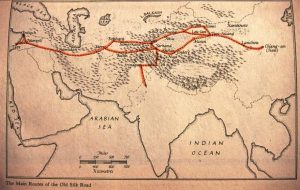 From the turn of the 19th century till about 1822, a vast amount of trade was diverted through Shekhawati and more and more merchants got attracted to the region. This was the meeting point of the camel caravans from the Middle East, China and India. Trade-in opium, cotton, and spices flourished. The merchant community that grew then is still a prominent class in Indian society today – the Marwaris. The huge sums of money that they dished out was to pay for the sheer volume of artistic expression that adorns the walls of Shekhawati. These Marwaris and Banias built palatial Havelis for themselves and memorials for their ancestors.
From the turn of the 19th century till about 1822, a vast amount of trade was diverted through Shekhawati and more and more merchants got attracted to the region. This was the meeting point of the camel caravans from the Middle East, China and India. Trade-in opium, cotton, and spices flourished. The merchant community that grew then is still a prominent class in Indian society today – the Marwaris. The huge sums of money that they dished out was to pay for the sheer volume of artistic expression that adorns the walls of Shekhawati. These Marwaris and Banias built palatial Havelis for themselves and memorials for their ancestors.
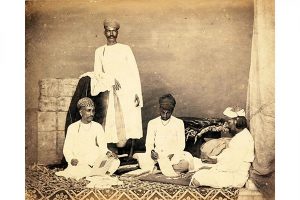
The flourishing cross-desert commerce wilted away as the British political set up grew stronger. More and more stress was being laid on the ports of Bombay and Calcutta instead, to establish monopolies for the East India Company. By the 1820s and 30s, it became more than clear that the future of trading did not lie in the sands of Rajasthan. But the Marwaris of Shekhawati would not be so easily put down. Leaving their native land, the menfolk migrated all the way to the upcoming eastern colonial capital to put their trading genius to good use. Between 1830 and 1930, they erected buildings in Shekhawati, their homeland, as evidence of their success. As the ultimate symbol of their opulence, the Marwaris commissioned artists to paint those buildings. India’s richest industrialists of the century, such as the Birlas and Dalmia, are Marwaris. Today, the main trading and industrial houses of India have their roots in Shekhawati. It is said that at one point in time 80% of the tax collectors were paid by the Marwaris.
Architecture
Haveli is a Persian word that means ‘an enclosed space’. The architecture of the Havelis provide a comprehensive system that governed the everyday lives of its inhabitants. Most of the Havelis of the Shekhawati region were constructed in between the 18th century and the early 20th century.
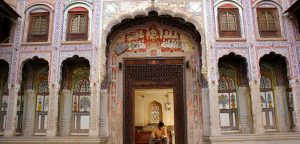
Unlike the Mughal havelis, the havelis of Shekhawati consist of two courtyards, one outer and one inner. The havelis are entered through a massive arched gateway, protected by a solid wooden door. The larger ones however have up to four courtyards and are two storeys high, The windows are exquisitely latticed and carved. Most of them feature mirror work and mural work while others are embellished with paintings. The facades, the gateways, the courtyard wall, the parapets and the ceilings were all covered with frescoes. Intricate wooden carvings with ornate iron and brass fittings demonstrate the owner’s wealth. It was from the latticed windows on the balconies and over the courtyards that women viewed the world. The havelis represented the rigid, but ostentatious lifestyle of the people. Shekhawati’s magnificent havelis or mansions, built by rich merchants of the region, display a unique architectural style that evolved around the courtyards to ensure safety and privacy of the women folk and protection from the heat of the long and harsh summers.

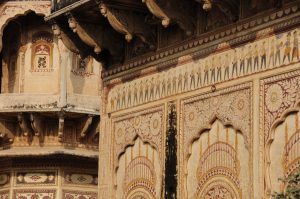
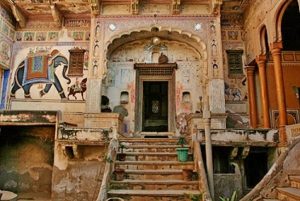
The Frescoes of Shekhawati
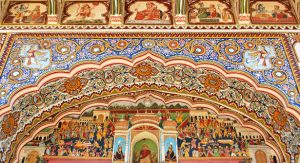 In Shekhawati, frescoes were initially introduced by Shekhawat Rajputs in their forts and palaces. This region has been recognised as the “open art gallery of Rajasthan” having the largest concentration of frescos in the world.
In Shekhawati, frescoes were initially introduced by Shekhawat Rajputs in their forts and palaces. This region has been recognised as the “open art gallery of Rajasthan” having the largest concentration of frescos in the world.
Shekhawati frescos ranged across a variety of themes, and changed over time, from the late 18th century when it began, to the early 20th century by when it had almost totally degenerated. The earlier wall paintings (1830 AD -1900 AD) were largely based on the mythological themes, depicting local legends, animals, portraits, hunting and wrestling scenes and a glimpse of everyday life. The turn of the 19th century saw the appearance of new motifs, an outcome of the Raj’s influence upon the Indian culture. Now cars, replaced elephants and traditional Indian miniatures mingled with naturalism of western paintings to produce interesting hybrid results.
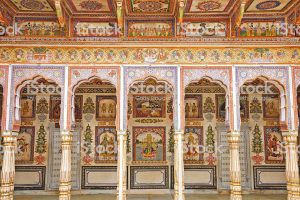 The mythological themes depicting gods, lithographs and photographs, Trains, cars, balloons, telephones gramophones English men in hunting attires and portraits of the haveli owners primly dressed were painted all over the walls. Hence, Krishna and Radha are seen in flying motorcars and Europeans can be observed inflating hot air balloons by blowing into them, or travelling in trains, the compartments of which look like English cottages.
The mythological themes depicting gods, lithographs and photographs, Trains, cars, balloons, telephones gramophones English men in hunting attires and portraits of the haveli owners primly dressed were painted all over the walls. Hence, Krishna and Radha are seen in flying motorcars and Europeans can be observed inflating hot air balloons by blowing into them, or travelling in trains, the compartments of which look like English cottages.
Culture Galore
Shekhawati is full of colors in almost everything like festivals, costumes, food, the colorful
spirits of the people to wear the bright colors of make up. The three million people of the region speak the Shekhawati language which is a dialect of the Rajasthani language.
Folk music and dances are irreplaceable parts of the rich Shekhawati culture. Folk songs are commonly ballads which relate heroic deeds and love stories; and religious or devotional songs known as bhajans and banis. Reflecting the colorful culture, the clothes have a lot of mirror-work and embroidery. The dress for females comprises an ankle length skirt (lehnga) and a short top(choli). A piece of cloth is used to cover the head, both for protection from heat and maintenance of modesty. The men wear plain white kurtas and crisp white bottoms with colorful turbans. The dresses are usually designed in bright colors like blue, yellow and orange. The people in the region adopt either farming or trading as a profession.
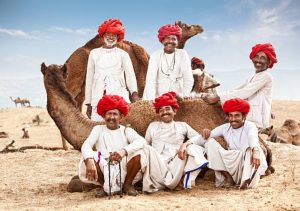
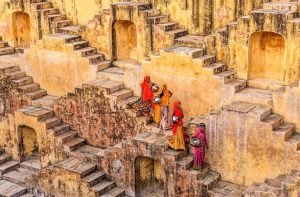
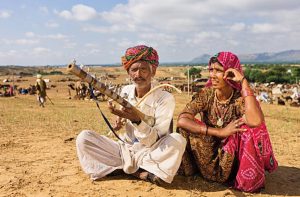
Festivals of Shekhawati
Shekhawati is the land of colorful festivals synonymous with the colorful spirits of the people. The main festivals celebrated are:
Gangaur Festival: Gangaur Festival is a very popular and very significant festival celebrated all over the region. It is dedicated to Goddess Gauri (Parvati), the companion of Lord Shiva. Celebrated in the months of July and August, the rituals are done by the women for the well being of the Husband and family.
Holi:The “festival of colours” is indeed celebrated in a very colourful manner in Shekhawati and is one of the biggest festivals for the natives. The atmosphere is charged up during the celebrations.
Teej : Teej is observed by women for wellness of their husband. Dedicated to the Goddess Parvati, commemorating her union with Lord Shiva, the festival is celebrated for sexual bliss, well-being of spouse and children and purification of own body and soul. The festival is a threeday- long celebration that combines sumptuous feasts as well as rigid fasting.
Shekhawati Festival: The Shekhawati Festival is organized by the State Department of
Tourism, District administration of Sikar, Jhunjhunu and Churu and the M.R. Morarka- GDC Rural Research Foundation Shekhawati. It is organized at a number of places in Rajasthan, including Nawalgarh, Sikar, Jhunjhunu and Churu. A number of activities like rural games, cultural programmes, haveli competitions and fireworks etc. are held to entertain the guests. it also hosts a gala event for the sale and purchase of cattle.
Camel Fair: A lively and colorful event, the Camel Festival is organized by the Department of Tourism, Art & Culture every year. The Camel Festival begins with a colorful procession of bedecked camels and the festiviy advances to the open sand-spreads of the grounds, followed by the best breed competition, the tug-of-war contest, camel dance and acrobatics, etc. The camels display amazing footwork, dancing gracefully to the slightest direction of their trainers. Bridal, bridles, be jeweled necks, jingling anklets and long, lanky camel shadows on dusky sands cast a magical spell.
Kite Flying: Every year 14 January is celebrated in India as Makar Sankranti – heralding the transition of the sun into the Northern hemisphere. It is also a big kite day in most parts of India when children from 6 to 60 can be seen with their heads turned to the sky. In Jaipur kites virtually blot out the sky. Everyone joins in this riotous celebration and shouts of “Woh Kata Hai!” reverberate from rooftops to the accompaniment of drums as adversaries’ kites are cut down. And everyone’s an adversary! Any kite in the sky is fair game.
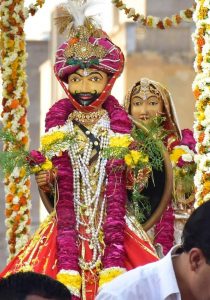
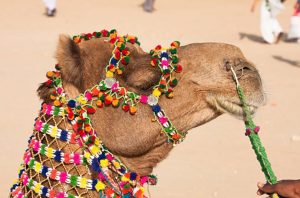
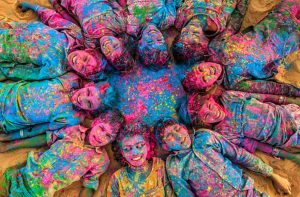
The Gods of Shekhawati
The religion of Shekhawati usually includes worship of Bhainroon (Shiva) and Krishna as well as Durga. They generally worship the Sun, Lord Shiva, Lord Vishnu and Bhavani (Goddess Durga). Apart from them there are many local gods and goddesses worshipped by the people of Shkhawati. These include Karni Mata, Nagnichi Devi, Kalika Ji, Mansa Devi, Kali Mata, Bhadrakali Mata, Shila Mata, Sakraya Mata, Rai Mata, Jeen Mata, Rani Sati Mata.
Shekhawati Cuisine
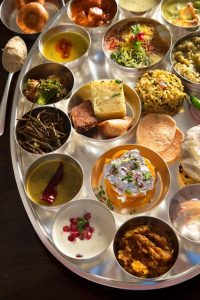 The Food of the Shekhawati region is primarily Rajasthani with influences of the Mughal and European cooking. Since the region experiences shortage of water one can notice the effect of the lack of fresh green vegetables and the food is prepared with milk, clarified milk and buttermilk.
The Food of the Shekhawati region is primarily Rajasthani with influences of the Mughal and European cooking. Since the region experiences shortage of water one can notice the effect of the lack of fresh green vegetables and the food is prepared with milk, clarified milk and buttermilk.
The delicacies have gram flour as a major ingredient. It is used to prepare Rajasthani delicacies such as ‘khata’, ‘pakodi’ and ‘ghatta ki sabzi’. To make rotis or chapattis, rabid and kheechdi, Bajra and corn are used. The delicious chutneys prepared with spices such as turmeric, mint, garlic and coriander are worth tasting.
Some of the mouthwatering Rajasthan cuisine are Ker-Sangri on Bajara Roti, Rajasthani Dal- Bati-Churma, Khud Khargosh, Chaavadi, Dhungari hui chaach, Jhajariya, Gevar, Panchkoota, Balusahi and Tarfini. The famous non vegetarian dish of the region is Laal Maans.
Visit our Walkthrough in Vivaana to know the whole Shekhawati Story.

